It has long been a dream of mine to visit Heron Pond Nature
Preserve in the winter. However,
whenever there is a large snow event in southern Illinois, there is a strong
incentive to stay indoors. But I've
always wondered how difficult it would be to get into the swamps of the Cache
River wetlands in the winter. This week
I finally got my chance.
After receiving 8-12 inches of snow in southern Illinois on
February 16 in the year of 2015, I made it out to explore Heron Pond. The minor road leading to the preserve from
Belknap road was not plowed at all, but other vehicles had traveled the road
and compacted the snow. I was able to
make it up the hill to Max Hutchison's house with relative ease in my all-wheel
drive Subaru, but the road beyond this point was untrammeled by vehicle or by human
foot.
 |
| My car at Max's house and the untouched snow on the road to Heron Pond |
I was surprised by this since I was not able to make it out
there until the day after the snowstorm.
I guess I figured others had the same foolish endeavor to walk out to
see winter work its magic on Heron Pond.
Clearly the locals and other nature lovers were far more sensible than
I. I parked my vehicle in Max’s
driveway, checked in with the Hutchison family, and geared up for the hike through
the snow.
Unfortunately, I did not have my cross country skis or
snowshoes with me, because the conditions were perfect for their use. How amazing would it have been to ski out to
see a Cypress swamp! But instead I was
left to lift foot after foot into the deep powder and it seemed like forever
just to reach the parking lot.
 |
| Bridge over the Cache River and the trailhead |
I walked down the hill and over the bridge. The Cache River was frozen except the spots
just after the rock weirs. These are
structures created to slow down the flow of the river, to reduce stream
downcutting in the upper reaches of river and to reduce sediment transfer to
the lower reaches of the river.
 |
| Rock weirs on the Cache River |
The snow made it easy to see the movements of animals. I noticed abundant deer and squirrel tracks,
and even some mink or otter activity along the river. I spotted a red-headed woodpecker, brown thrush, some
mallards, and an owl that flew off as I approached the boardwalk. It was marvelous to see such a prized and highly visited spot in such unadulterated beauty. The solitude made me think I was in a vast wilderness, yet I was just a couple miles from my car.
 |
| My tracks on the boardwalk and the virgin powder on the trails and stepping stones |
Max advised me to not go out on the ice, although he
admitted that the best time to explore the swamp was when it was frozen. Since the boardwalk extends into the swamp, I
did not feel the need to walk out on the ice, although it did look plenty thick. Just as I was leaving, the sun
poked through the Cypress trees and I got the shot I was looking for.
 |
| Cypress Swamp at Heron Pond Nature Preserve |
On the way back to my vehicle, I reveled in the fact that
the only human tracks in the snow were mine.
This is truly a magical place and I was truly elated to experience it in
a whole new element. Once I returned to
Max’s house, I had to stop in and what do you know, of course they insisted I
stay for chili and cornbread. Who could
turn down such a request?
 |
| Chili and cornbread at the Hutchison's |









